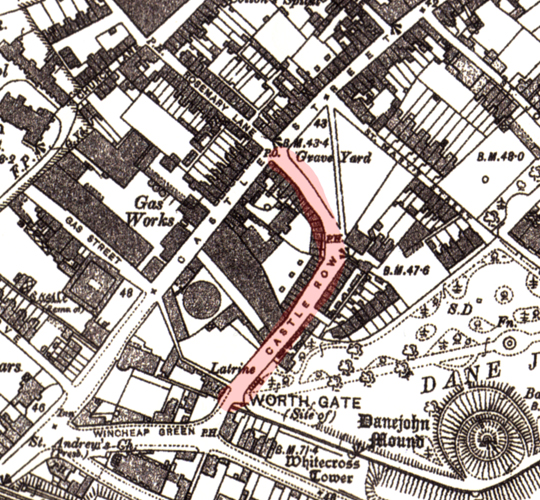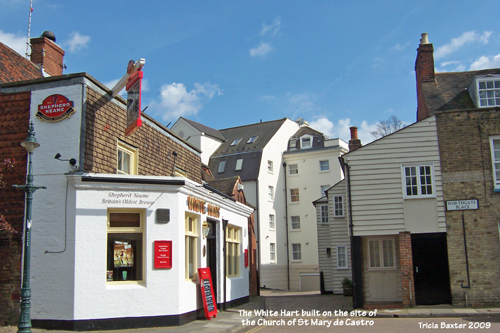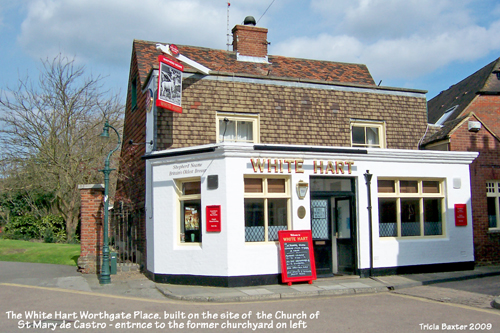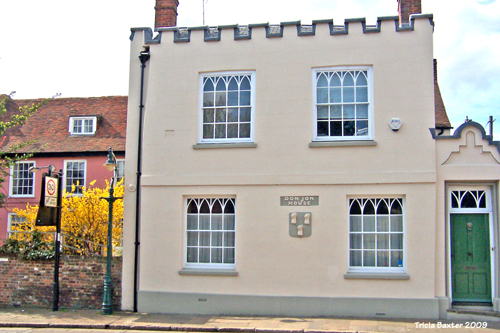
![]()
~ CASTLE ROW ~
CANTERBURY
St. Mildred
Clearance of houses 29-33 Castle Row

Dane John Cottage, Castle Row
John BATEMAN, Retired Carpenter %
Jem
WHITE HART, Castle Row


The White Hart built on the site of the Church of St. Mary de Castro
John JORDAN,Victualler %
John JORDAN, Licensed Victualler, wife Ann ^
Harriet HOLMES, Publican

Don John House, Castle Row

No. 1
Esther Fordred, Lodging keeper %
James Gaskin, Bricklayer %
No. 2
Amelia AUSTIN %
Robert WILKINSON, Tailor %
No. 3
Lydia COLEMAN, Straw Bonnet Maker %
Charles Chapman, Tanner %
James Smith. What are you? Painter. Where do you live? Castle Row. Did you get any money over the last election? No. Or give away any? Never. Do you know Mr. Edward Williams, the tailor? No I do not. ....Do you live at 3 Castle Row? It is altered now, but I am on the register for 3 Castle Row. Is there any other James Smith on the register? That I cannot say." Parliamentary Papers
No. 4
John COOMBS, Labourer %
No. 5
Thomas GILBY, Tailor %
Henry B. Collis, Photographer *
No. 6
William GASKIN, Bricklayer %
No. 7
Henry TAYLOR, Shoemaker %
William G. BUSH, Cellarman of Ale Stores *
No. 14
John WOOD, Labourer %
Wincheap Green to Castle Street (left from Wincheap Green)
ASH & CO's MALT HOUSE
No. 15
George Richards, General Labourer *
1917 Edward LYNN
No. 16
Stephen HUXSTEP %
1917 Miss M. SWAIN
No. 17
THOMAS TERRY, Bricklayer, wife Jane, Straw bonnet maker, son Thomas Terry, and daughters, Elizabeth and Rachael %
death 1902 PAIN - July 21, at 17 Castle Row, Canterbury, James PAIN, aged 78 years
1917 Mrs. LUCKHURST
No. 18
James FEDARB, Cordwainer %
1917 Robert HART
No. 19
Samuel Lewis, Coachman %
1917 Henry James CORK
No. 20
Charles Chambers, Policeman %
1917 William GILES
No. 21
Reubin Bingham, Woolstapler %
James FEDARB, Cordwainer *
1917 Mrs. HOLLIDAY

Castle Row towards Rosemary Lane crossed by Castle Street with St. Mary's yard on the right
No. 22
Ann KNOTT, Laundress %
Thomas WALLER, Prudence & Susan SEWELL %
1917 William PARTRIDGE
No. 23
George Richards, Labourer %
1917 George BARTLETT
No. 24
Richard Hosmer, Labourer %
Thomas FEDARB, Ginger Beer Maker *
1917 Carlos PAIN
No. 25
Elizabeth Gilnor, Fanny Spicer, Mary Coultham %
1917 Archibald WARNER
No. 26
Charlotte Black %
1917 John Joseph WILSON
No. 32
Mr. WHITE !!
No. 33
Edward Tomlin, Painter *
Mr. HADLOW !!
1917 Abraham GAWLTER
No. 41
William W. J. Hookway, Carpenter & Joiner *
PP. William Thomas Hookway - Where do you live? 41, Castle Row. What are you? A Joiner. Did you get anything at the last election? I got 5l. from Mr. Mudford.
Mr. ANSELL !!
1917 James HEAD
Left from Castle Street
1917 WHITE HART, F. C. EMERY
Worthgate Place
Entrance to Dane John
1830
John Bateman, Castle Row, Carpenter
John Stone, Castle Row, Turner
John Dombrain, Castle Row, Hop Planter
Sherwood T. Weston, Castle Row, Plasterer
James Fedarb**, Cordwainer $
**From a list of Freeman 1830 (no addresses, Daniel Fedarb, John Fedarb, Jacob Fedarb, James Fedard(b)? and Thomas Fedarb)
Eliza Filmer $
Frederick Papeson $
John Knell, Cordwainer $
Charles Chambers, Police Constable $
Samuel Street, Cabinet Maker $
Thomas Robinson, Cordwainer $
John Coombs, Brewers Servant $
John Hawkes, Attorneys Clerk $
Harry Coombs, Brewers Servant $
Elizabeth Smith, School Mistress $
John Solly, Shoemaker $
Charles Spicer, Labourer $
Thomas Foord, Labourer $
Stephen Huxslep, Labourer $
Elizabeth Mexfield $
Elizabeth Miller, French Governess $
William Kelsey, Bricklayer $
Thomas Huxslep, Brewers Servant $
William Nisbett, Publican $
(extra parochial Old Casle Precinct)
James Hennicker, Clerk in a Brewerey $
SOUTHGATE HOUSE - Nelson Collard, Corn Factor $
Harriet Newport, Dress Maker $
William NEWPORT, Wheewright $
(George Newport, Esq. F.R. S. - death April 7. At his residence in Cambridge Street, Hyde Park, after a short illness attended with fever, aged 51, George Newport, esq. Fellow of the Royal Collage of Surgeons, and of the Royal Linnean and Entomological Societies and also of many similar societies on the continent and in America. This gentleman was the son of a wheelwright at Canterbury and was himself apprenticed to the trade. He worked for a time at the hammer and anvil, but his attention being early drawn to a museum of natural history, established in that town by Mr. Masters, the nurseryman, he turned from the structure of wheels to that of insects, and obtained the post of Curator. He commenced with great zeal to study the anatomy of articulated animals, and selecting medicine for his profession, he became a student of University College, London. Here he attracted the attention of Dr. Grant, and during his vacation rambles, he continued diligently to observe the habits and economy of the insect world. He paid frequent visits to places in his native county, especially to Richborough, near Sandwich, and his observations were made on the commonest species. As an instance of the value and originality of his researches, we may mention that the humble bee, the white cabbage butterfly the tortoise shell butterfly, and the buff tip moth, afforded him materials for papers deemed of sufficient importance for publication in the Philosophical Transactions of the Royal Society. But the great triumph of Mr. Newport's anatomical researches was his discovery that in the generative system of the higher animals, the impregnation of the ovum by the spermatozoa is not merely the result of contact, but of penetration; and for his paper published in the Philosophical Transactions of the Royal Society for 1851 entitled, "On the Impregnation of the Ovum in the Amphibia," Mr. Newport had the distinguished honour to receive the Society's Royal Medal. He contributed, also, numerous valuable papers on insect structure to the Transactions of the Linnaean Society, and to the Entomological Society, of which he was for two years President. He wrote occasionally in periodicals, as for example, the article Insects, in the "Cyclopaedia of Anatomy and Physiology." and though his pursuits were not greatly varied, he studied also the archaeology of his native county and cathedral. Mr. Newport settled at the west end of London as a surgeon, but his heart and mind were to much engrossed in microscopical investigation, leading to philosophic ends to obtain much practice. He possessed sincere and interested friends in Dr. Marshall Hall, Sir John Forbes, and Sir James Clark; and the last procured him a pension from the civil list of 100£ per year. He exercised great facility in making his dissections, and acquired a dexterity in drawing either with the right hand or the left, which in his demonstrations of insect anatomy and physiology was invaluable. His style of writing was flowing and agreeable though some might pronounce it to be verbose. In all cases his papers, even though on abstruse details are very readable. Mr. Newport was morbidly sensitive to criticism, and viewed with a somewhat jaundiced eye the labours of others. Hence among little minds he made combative and bitter enemies. Not very long since an attack, hardly justifiable, was made in the "Annals and Magazine of Natural History, "upon his researches on the Blood and Respiratory Structures of Animals; and sure of his strength, one of the latest acts of Mr. Newport's life was to address a note to that periodical, in which he says, "I have observed with surprise and regret such a mass of erroneous statements, that I shall feel called upon to attempt to remedy the injury which those errors are likely to inflict on science by their promulgation." Mr. Newport's skill in a minute demonstration was remarkable, and his views were always sound. A medal offered by the Agricultural Society of Saffron Walden for the best Essay on the Turnip Fly was readily gained by him; and his researches made during the last few years on the embryology and reproduction of Batrachian reptiles, and out of which the discovery just noted was elicited, have gain him universal renown. Mr. Newport was a member of the Council of the Royal Society at the time of his decease, and only the day previous was dictating from his bed on his favourite subject of the impregnation of the ovum. The wheelwright of Canterbury lived to receive the highest honours for researches in natural knowledge which this country has to bestow; and it remains to mourn that a naturalist of such high philosophic powers should have been cut off in the zenith and vigour of his useful career. Literary Gazette "A subscription (limited to one guinea) has been set on foot among the Fellows of the Royal and Linnaean Societies for a tombstone over his grave")
Lydia Pearson, Independent $
Amy & Frances Pullee, Independent $
James Houlden, Stone Mason $
*Will of James Houlden, Mason of City of Canterbury, Kent (January 17, 1856)
Thomas Dorman, Independent $
William Collard, Farmer $
Thomas Swinyard $
GAS WORKS - James Browne, Independent $
1847 Mr. John Bateman, Castle Row
Many of the men on this street were general labourers